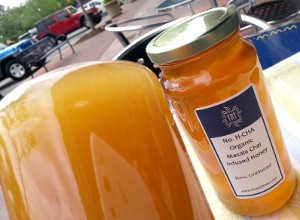Why does honey crystallize?

Why does honey crystallize? In the back of Tin Roof Teas, you will find our ever-expanding honey section. Raw honeys with very distinctive flavors, and origins. Being the honey is raw, we play havoc trying to keep the golden liquid fluid. No one really wants to buy a honey that is beginning to crystallize, but they want raw honey…ah the conundrum of it all. So, why does honey crystallize, and what to do about it?
The main reason honey doesn’t go bad, is because of its chemical make-up. Honey is primarily sugar mixed with a little water. This natural, low-moisture state deters bacteria and yeast, both of which find dry conditions inhospitable. However, honey as a substance is inherently dry and has a tendency to crystallization, the process that causes honey to become thick, cloudy, and undesirable to some. The process of crystallization, which can occur at any length of time depending on the amount of sucrose within the honey’s composition are determined by several factors.
First, there are the conditions of the room in which the honey is stored. Hot conditions, mimic the hive and protect the honey from crystallization. The hive is usually around 92-95 degrees Fahrenheit. Heat can degrade honey after long periods and it then becomes susceptible to yeast and bacteria. Temperatures that are too cold, however speed up crystallization. Honey is best kept at temperatures around 70 degrees Fahrenheit.
As I touched on a little earlier, the type of honey and the level of sucrose sugars also contribute to the speed in which honey tends to crystallize. There are over 300 types of honey sold in the U.S. and each type changes at a different rate. Tupelo, which is low in sucrose and great for diabetics is also high in fructose and can last for years without crystallization. Cotton and Dandelion blossom honey tend to crystallize very quickly because of their respective chemical make-up.
Crystallization is not a bad thing. It is used to create smooth, and creamy honeys that are spun, and then blended with fruit and spices. Think creamed honey! Yum!! At the house, we choose to use our honey in different forms depending on the state of the honey. If it’s liquid, then we use it for cooking, and allergies. If it’s crystallized, we use it as a spread for toast or biscuits. Of course, it will always work with tea or coffee, regardless of a liquid or a crystallized state.
If you would like to de-crystallize your honey, then bring a pot of water right under 100 degrees Fahrenheit and allow the honey to sit in the water for about 10 minutes. Keep the honey well below 115 degrees Fahrenheit, or you will begin to cook out all of the minerals and vitamins. The goal is to keep your raw honey, well, raw.
Source: www.scienceline.org/2007/04/ask-westly-crystallizedhoney/

